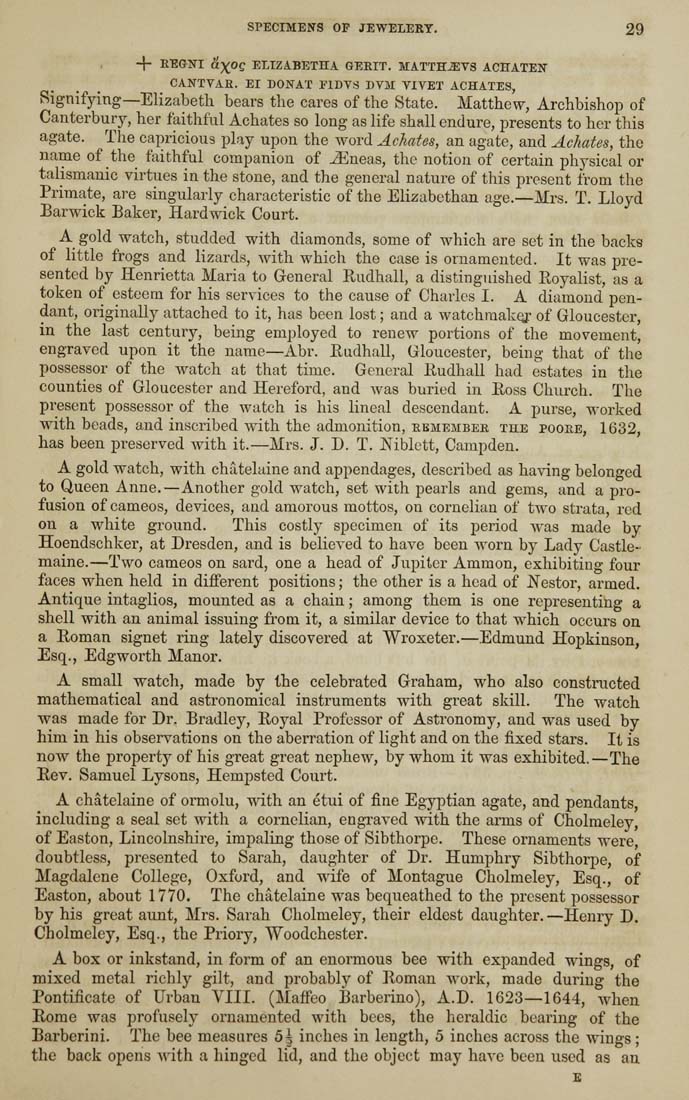SPECIMENS OF JEWELERY.
29
+ REGNI &X°S ELIZABETHA GERIT. MATTH.SVS ACHATEN
CANTVAR. EI DONAT F1DVS DVM VIVET ACHATES,
Signifying—Elizabeth bears the cares of the State. Matthew, Archbishop of
Canterbury, her faithful Achates so long as life shall endure, presents to her this
agate. The capricious play upon the word Achates, an agate, and Achates, the
name of the faithful companion of jEneas, the notion of certain physical or
talismanic virtues in the stone, and the general nature of this present from the
Primate, are singularly characteristic of the Elizabethan age.—Mrs. T. Lloyd
Barwick Baker, Hardwiek Court.
A gold watch, studded with diamonds, some of which are set in the backs
of little frogs and lizards, with which the case is ornamented. It was pre¬
sented by Henrietta Maria to General Rudhall, a distinguished Royalist, as a
token of esteem for his services to the cause of Charles I. A diamond pen¬
dant, originally attached to it, has been lost; and a watchmaker of Gloucester,
in the last century, being employed to renew portions of the movement,
engraved upon it the name—Abr. Rudhall, Gloucester, being that of the
possessor of the watch at that time. General Rudhall had estates in the
counties of Gloucester and Hereford, and was buried in Ross Church. The
present possessor of the watch is his lineal descendant. A purse, worked
with beads, and inscribed with the admonition, remember the poore, 1632,
has been preserved with it.—Mrs. J. D. T. Kiblctt, Campden.
A gold watch, with chatelaine and appendages, described as having belonged
to Queen Anne.—Another gold watch, set with pearls and gems, and a pro¬
fusion of cameos, devices, and amorous mottos, on cornelian of two strata, red
on a white ground. This costly specimen of its period was made by
Hoendschker, at Dresden, and is believed to have been worn by Lady Castle-
maine.—Two cameos on sard, one a head of Jupiter Ammon, exhibiting four
faces when held in different positions; the other is a head of Nestor, armed.
Antique intaglios, mounted as a chain; among them is one representing a
shell with an animal issuing from it, a similar device to that which occurs on
a Roman signet ring lately discovered at Wroxeter.—Edmund Hopkinson,
Esq., Edgworth Manor.
A small watch, made by the celebrated Graham, who also constructed
mathematical and astronomical instruments with great skill. The watch
was made for Dr. Bradley, Royal Professor of Astronomy, and was used by
him in his observations on the aberration of light and on the fixed stars. It is
now the property of his great great nephew, by whom it was exhibited.—The
Rev. Samuel Lysons, Hempsted Court.
A chatelaine of ormolu, with an etui of fine Egyptian agate, and pendants,
including a seal set with a cornelian, engraved with the arms of Cholmeley,
of Easton, Lincolnshire, impaling those of Sibthorpe. These ornaments were,
doubtless, presented to Sarah, daughter of Dr. Humphry Sibthorpe, of
Magdalene College, Oxford, and wife of Montague Cholmeley, Esq., of
Easton, about 1770. The chatelaine was bequeathed to the present possessor
by his great aunt, Mrs. Sarah Cholmeley, their eldest daughter. —Henry D.
Cholmeley, Esq., the Priory, Woodchester.
A box or inkstand, in form of an enormous bee with expanded wings, of
mixed metal richly gilt, and probably of Roman work, made during the
Pontificate of Urban VIII. (Maffeo Barberino), A.D. 1623—1644, when
Rome was profusely ornamented with bees, the heraldic bearing of the
Barberini. The bee measures 5 J inches in length, 5 inches across the wings;
the back opens with a hinged lid, and the object may have been used as an
E
|








